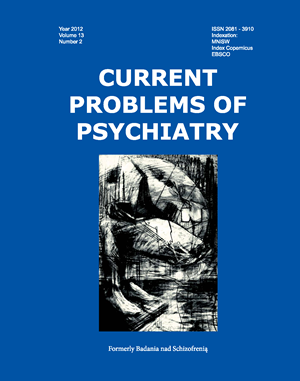On the essence of the dyssolutional disorder
Keywords:
schizophrenia, dyssolutional disorderAbstract
Schizophrenia, which the author of the psychophysiological theory, Jan Mazurkiewicz, calls the dyssolutional disorder, is a slow-progressing, chronic disease. In schizophrenia, impairment of the evolutionarily highest level structures of the nervous system leads to pathological changes in evolutionarily lower functions, which manifest themselves as psychotic symptoms, e.g., delusions or hallucinations. For many months, and sometimes even years, the disease develops insidiously, taking the form of the so-called pre-psychotic phase. When psychosis manifests itself, hospitalization is generally required. Mazurkiewicz distinguishes two categories of symptoms. Positive symptoms, such as hallucinations, respond well to medication. More problematic are refractory deficit (negative) symptoms, which may become manifested only after remission of the acute phase of the disease. They are a consequence of the devastation of patients’ emotional life, which results in a changed personality structure. This article presents the achievements of the Lublin Department of Psychiatry in diagnosing the symptoms which represent the essence of schizophrenia, i.e. character changes. Kaczyński’s description of changes of character in early schizophrenia, enriched with results of research conducted for many years by the staff of the Department, enable fast diagnosis and development of a suitable treatment and social rehabilitation program.
References
1. Perzyński J. Zaburzenia schizoafektywne a choroba dyssolucyjna. Current Problems of Psychiatry. 2000,11(13), 179-182.
2. Mazurkiewicz J. Wstęp do psychofizjologii normalnej. T.II. Dyssolucja aktywności korowo-psychicznej. PZWL, Warszawa, 1998.
3. Kaczyński M. Symptomatologia wczesnej schizofrenii. Neurol. Neurochir. Psychiatr. Pol. 1957, VII, 4, 505-511.
4. Kaczyński M. Zmiany psychiczne w przebiegu leczonej wczesnej schizofrenii. Przegląd lekarski, 1958, XIII, 31, 1-11.
5. Kaczyński M. O zmianach charakterologicznych we wczesnej schizofrenii. Neurol. Neurochir. Psychiatr. Pol., 1962, XII, 4, 545-549.
6. Minkowski E. Z zagadnień schizofrenii. Neurol Neurochir. Psychiatr. Pol., 1957, VII, 4, 495-503.
7. Perzyński J. Mapa dyssolucyjna: dysolucja wewnątrzpiętrowa prepsychotyczna. Zespoły rzekomo nerwicowe wczesnej schizofrenii. Badania nad schizofrenią, 2009, X, 10, 17-22.
8. Brzezicki E. Katamneza i prognoza w ostrych psychozach młodzieńczych. Psychiatr. Pol., 1971, 7, V, 379-386.
9. Perzyński A. Zmiany charakterologiczne po pierwszym epizodzie schizofrenii paranoidalnej. Praca doktorska. Uniwersytet Medyczny, Lublin, 2011.
10. Perzyński J. Próba interpretacji wybranych cech obrazu klinicznego schizofrenii jako choroby piętrowo-dyssolucyjnej. Badania nad schizofrenią, 2006, VII, 7, 26-31.
11. Brzezicki E. Kilka uwag o nowym syndromie: Schizofrenia paradoksalna społecznie korzystna. Przegląd lekarski, 1961, XII. 8, 290-291.
12. Perzyński J. Z badań nad zmianami charakterologicznymi wg opisu M. Kaczyńskiego w przebiegu schizofrenii paranoidalnej. Pamiętnik III Lubelskich Spotkań Naukowych, Lublin, 13-15.05.1993, Lublin, 1993, 62-66.
13. Kępiński A. Schizofrenia. Warszawa; PZWL: 1972.
14. Perzyński J. Mapa dyssolucyjna. Badania nad schizofrenią, 2008, IX, 9, 13-20.
15. Perzyński J. Typy i kierunki dysolucji. Badania nad schizofrenią, 2007, VIII, 8, 13-20.
16. Drake R.J., Levis S.W. Wczesne rozpoznawanie schizofrenii. Current opinion in psychiatry, Wyd. Polskie Red. Prof. M. Jarema 2005, Tom 3, 13-17.


